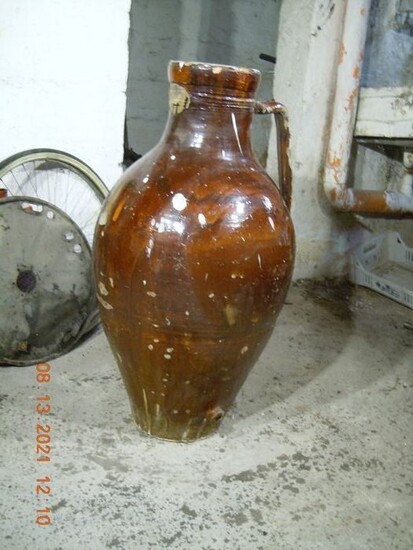Jar - Earthenware - Second half 20th century
Handcrafted ceramic wine containers from the 1960s, from the ancient Mediterranean pottery tradition, in good condition, with some missing pieces Ceramic is one of the typical products of the territory, it has its fulcrum in the city of Grottaglie, in the province of Taranto, one of the 28 Italian cities of ceramics whose artefacts have been awarded the D. O. C. mark. The territory holds red clay which is transformed by human hands into objects for domestic use and true artworks. Suffice it to say that over the centuries, in the heart of the city, along the Gravina of San Giorgio, a real neighbourhood has developed thanks to this craft. There, expert potters have opened their workshops and shops, making kilns out of the rock of ancient underground rooms, once also used as oil mills. The medieval ceramics district of Grottaglie, where clay is still worked today, arose in the 14th century, when the first settlement, the 'Camenn're' (literally, 'the chimneys', i. e. the kilns) was formed. A document of the Royal Customs of Taranto of 1463 certifies the production and trade of majolica. At the time, Grottaglie had become the largest supplier of ceramic products for home use, serving the commercial port traffic. Starting from 1567, archival documents listed potters qualified as "Cretari", that is, those producing objects of common use. In 1600 appeared some "faenzari", those dedicated to a more refined ceramic processing. There are two main products of the Grottaglie tradition: the most characteristic and rustic is characterized by a chromatic palette consisting of green, ochre yellow, blue and manganese. The famous Capasoni (from 'capase', meaning capable) , large containers shaped into distinct sections and mainly intended to contain wine, and the Minzane to contain water, belong to this production.
[ translate ]View it on
Estimate
Time, Location
Auction House
Handcrafted ceramic wine containers from the 1960s, from the ancient Mediterranean pottery tradition, in good condition, with some missing pieces Ceramic is one of the typical products of the territory, it has its fulcrum in the city of Grottaglie, in the province of Taranto, one of the 28 Italian cities of ceramics whose artefacts have been awarded the D. O. C. mark. The territory holds red clay which is transformed by human hands into objects for domestic use and true artworks. Suffice it to say that over the centuries, in the heart of the city, along the Gravina of San Giorgio, a real neighbourhood has developed thanks to this craft. There, expert potters have opened their workshops and shops, making kilns out of the rock of ancient underground rooms, once also used as oil mills. The medieval ceramics district of Grottaglie, where clay is still worked today, arose in the 14th century, when the first settlement, the 'Camenn're' (literally, 'the chimneys', i. e. the kilns) was formed. A document of the Royal Customs of Taranto of 1463 certifies the production and trade of majolica. At the time, Grottaglie had become the largest supplier of ceramic products for home use, serving the commercial port traffic. Starting from 1567, archival documents listed potters qualified as "Cretari", that is, those producing objects of common use. In 1600 appeared some "faenzari", those dedicated to a more refined ceramic processing. There are two main products of the Grottaglie tradition: the most characteristic and rustic is characterized by a chromatic palette consisting of green, ochre yellow, blue and manganese. The famous Capasoni (from 'capase', meaning capable) , large containers shaped into distinct sections and mainly intended to contain wine, and the Minzane to contain water, belong to this production.
[ translate ]


